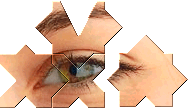The movie "Girl Interrupted", is an adaptation of Susanna Kaysen's
autobiographical book of the same name (set in the late 1960s)
and is essentially about a woman with Borderline Personality
Disorder who is voluntarily institutionalized (signs herself in
at the age of 18) after trying to committ suicide. The movie
attempts to chronicle Susanna's (Winona Ryder) experiences in
therapy as an in-patient in Claymoore women's ward.
The movie is interesting, suspenseful and touching
in many ways but it fails to accurately portray Borderline
Personality Disorder. It hits upon a few borderline characteristics,
namely identity confusion, career confusion, impuslivity (sexually)
unstable relationships (barely touched upon and not developed in the
over-all plot) and suicidality.
The acting is superb. The ensemble cast is believable. But what
is lost is Susanna's turmoil which is overshadowed by the character
of Angelina Jolie who plays a sociopath. At times it is hard to tell
who the main character really is. Adding to this, much of the antics
of the in-patients are just not believable.
Setting up the revelation of Susanna's BPD diagnosis in the
shadows of Lisa's (Angelina Jolie) sociopathic lack of empathy,
emotion or conscience will subtly convey to those paying close
attention that borderlines are redeemable and that they are not
as far gone as are those who live without conscience.
For those hoping that this movie would truly address Borderline
Personality Disorder, as I was, it is a tremendous disappointment.
It gets close in a seveal scenes to an accurate portrayal of BPD
but only to fall short time and time again.
The movie does manage to convey the reality that the main
character, Susanna does indeed move along in her journey from
vulnerable fear to self-awareness. There is a sense of watching
someone finding their authentic self and winning the battle against
the false-self. Susanna transforms herself from a depressed, angry,
and suicidal follower who is essentially lost and without purpose
to a vital young woman, who finds some peace, a reason to live and
who takes on the ability to lead her own self-directed life. The
problem is that the plot is not well-developed enough in its detail
and does not clearly take us on the journey that Susanna travels.
One highlight however, is a scene in which a nurse (Whoopi Goldberg)
confronts Susanna in a way that is a turning-point for her. Susanna
comes to confront a moment of truth and of choice. I thought that
the movie portrayed, the reality that each borderline has a choice to
make, and that one must CHOOSE to heal, very well.
The movie ends in a very meaningful way both for the character,
the viewer and those interested in the borderline aspects of it.
Susanna's words at the end echo the deep-inner truth that must be
realized if one is to heal from BPD.
Misleading, I thought, was the way in which the movie portrayed
Susanna's healing as having taken place and been completed in those
18 months. Perhaps this was this woman's truth but I find it hard to
believe that anyone, especially, at 18-19 years of age could fully
heal from BPD so fast, let alone at all. (at that age) I would think
that Ms. Kaysen had challenges yet to face in her healing journey.
I thought that the message of such fast healing was one of false-hope
at best and was very misleading at worst.
The movie's theme seemed to challenge the viewer to think about
what crazy means. It also made it clear that while the
institutionalized world and the "real" world are indeed two
very separate places - being "crazy" or being "sane" may indeed not
be such separate experiences or realities after all.
I would recommend the movie, not so much for any education or
insight into Borderline Personality Disorder, but more just for
the entertainment value.
I for one, truly hope a better vehicle comes along to convey
the very poignant in's and out's of borderline personality disorder.
© A.J. Mahari August 14, 2000
 as of August 14, 2000
as of August 14, 2000



This page is © A.J. Mahari 2003-2004 and was last up-dated January 10, 2004

